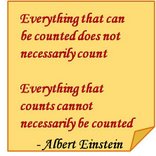
Linear discussion guides made to exacting specifications
I dislike voluminous discussion guides. What I dislike even more is that a researcher is expected to revise discussions guides repeatedly to set the tone just as the client expects it to be. In my early days, I came across some researchers actually memorising the guides, and i don't blame them. The structure of a guide (linear, flowing from page-to-page) does not lend itself to easy adaptation especially for a rookie with a client sitting in a back room, looking for a skipped question rather than intently listening to the discussion .
The futility of the effort is magnified since these guides don't serve the purpose in the first place. We are not programmed to think in a linear fashion. Our mental associations do not always follow patterns such as
1. xxxxxx
1.a yyyyyyyy
1.b zzzzzzzzz
Which is why you hear consumers jumping from one topic to another in their responses, and find a researcher frantically turning pages trying to mentally tick off points covered. Worse still trying to force the discussion back to a linear format. Instead of delving into mental associations, we focus on the discussion structure. Talk about missing the forest for the trees !
The Byzantine web of thoughts
The picture represents our neural structure. Our thoughts are organized and stored as a web of associations in the brain. One thought could trigger multiple thoughts along one or more dimensions. Besides, the development of these thoughts does not follow any pre-determined order or sequence. Sometimes even the very mention of a category / brand, could evoke a spring of thoughts in the consumer's mind. There is a divergence between the actual and the assumed process of cognition leading to a loss of information.
Mind-maps mirror our thought process
Mind maps like the one illustrated at the top can be constructed using any mind-mapping software. These are intuitive since these are a representation of our natural flow of thoughts.
- The mind map in lieu of a conventional discussion guide allows the researcher to scan the fluid pathways of information as the conversation evolves rather than jump back and forth between pages to keep pace.
- Its application and use in research does not stop there. In my limited exposure to mind-mapping i have found that it aids the mental process of capturing the 'information' areas before conducting research.
- While listening to consumer conversations, one can visualise some of the mental associations consumers make and their flights of thought as these happen.
- Visualising those flights of thought has also been useful, while analysing & drawing inferences from the data, since it eases the process of finding patterns to an extent.
Reference: You can find the link to download the mind-mapping software on this page To my mind it is easy to get used to !
Mind Map,Mind Map and Qualitative Research,Discussion Guide,Discussion Guide and Mind Map,

3 comments:
Mind mapping is truly a powerful tool and helps one to really explore a subject fully and to grapple the information into the best order to express that idea and press it home. I have found Spark-Space an excellent software package to use. Although it is not free the small fee is well worth the cost to get your hands on a really useful tool. You can view it and download a free trial at www.spark-space.com
bingo! linear is the way we have been conditioned to think.. it is just not natural.
and I loved the mental image of a reseacher franctically turning the pages of a discussion guide - do people even use them any more?!
and here is something I wrote on mind maps ages ago...
Anon - thanks for the tip off on spark space. will definitely give it a try
charu - yes they do use discussion guides still - and i guess it would be long before we see some radical changed in mainstream research
Post a Comment